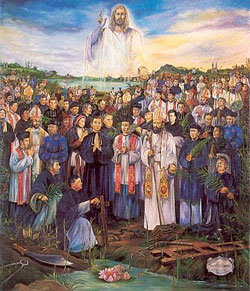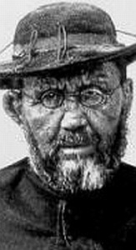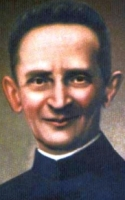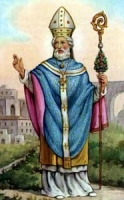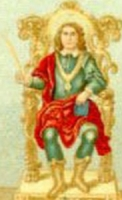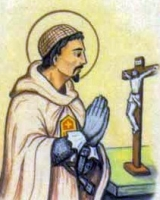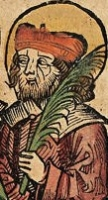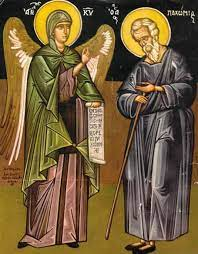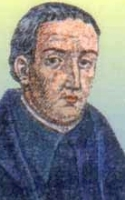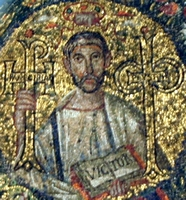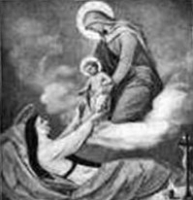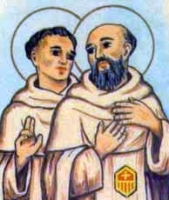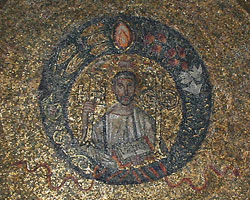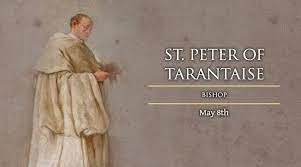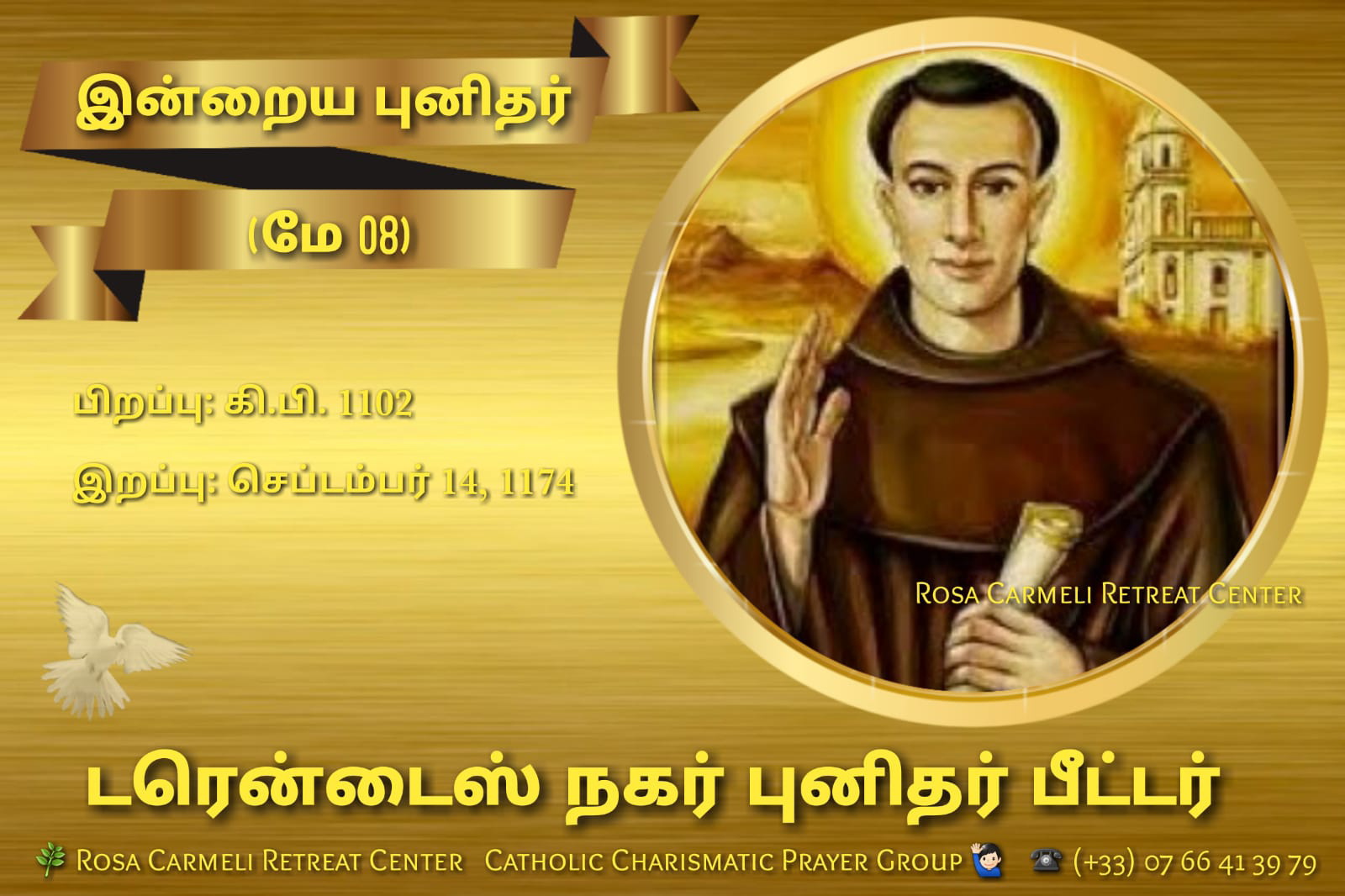St. Peter Van
Feastday: May 10
Death: 1857
Vietnamese martyr. A native catechist, he was arrested by authorities and beheaded. Pope John Paul II canonized him in 1988.
The Vietnamese Martyrs (Vietnamese: Các Thánh Tử đạo Việt Nam; French: Martyrs du Viêt Nam), also known as the Martyrs of Annam, Martyrs of Tonkin and Cochinchina, Martyrs of Indochina, or Andrew Dung-Lac and Companions (Anrê Dũng-Lạc và các bạn tử đạo), are saints on the General Roman Calendar who were canonized by Pope John Paul II. On June 19, 1988, thousands of overseas Vietnamese worldwide gathered at the Vatican for the Celebration of the Canonization of 117 Vietnamese Martyrs, an event chaired by Monsignor Tran Van Hoai. Their memorial is on November 24 (although several of these saints have another memorial, having been beatified and on the calendar prior to the canonization of the group).
St. Damien of Molokai
புனிதர் தமியான்
மதகுரு, மதபோதகர்:
(Religious Priest and Missionary)
பிறப்பு: ஜனவரி 3, 1840
ட்ரெமெலோ, ப்ரபன்ட், பெல்ஜியம்
(Tremelo, Brabant, Belgium)
இறப்பு: ஏப்ரல் 15, 1889 (வயது 49)
கலாவுபப்பா, மொலகாய், ஹவாயி
(Kalaupapa, Molokaʻi, Hawaiʻi)
ஏற்கும் சமயம்:
ரோமன் கத்தோலிக்க திருச்சபை
(Roman Catholic Church)
கீழைக் கத்தோலிக்க திருச்சபைகள்
(Eastern Catholic Churches)
அமெரிக்க எப்பிஸ்கோப்பல் திருச்சபை
(Episcopal Church)
ஆங்கிலிக்கத்தின் சில பிரிவுகள்
(Some Churches of Anglican Communion)
லூதரன் தனிச்சபைகள் சில
(Individual Lutheran Churches)
அருளாளர் பட்டம்: ஜூன் 4, 1995
திருத்தந்தை இரண்டாம் ஜான் பவுல்
(Pope John Paul II)
புனிதர் பட்டம்: அக்டோபர் 11, 2009
திருத்தந்தை பதினாறாம் பெனடிக்ட்
(Pope Benedict XVI)
முக்கிய திருத்தலங்கள்:
லுவென், பெல்ஜியம் (உடலின் மிச்சங்கள்)
(Leuven, Belgium (bodily relics)
மோலக்காய், ஹவாய் (அவரது கையின் மிச்சங்கள்)
(Molokaʻi, Hawaii (relics of his hand)
நினைவுத் திருவிழா: மே 10
பாதுகாவல்: தொழுநோயால் பாதிக்கப்பட்டோர்.
ஹவாயி இராச்சியத்தின் மோலக்காய் தீவில் தொழுநோயாளருக்குப் பணிபுரிந்து, தாமும் தொழுநோயால் பாதிக்கப்பட்ட புனிதர் தமியான், "இயேசு மற்றும் மரியாளின் திருஇருதய சபை" (Congregation of the Sacred Hearts of Jesus and Mary) என்னும் கத்தோலிக்க துறவற சபையினைச் சார்ந்த துறவியும், குருவும் ஆவார்.
பிறப்பும் துறவறமும்:
தந்தை தமியான், கி.பி 1840ம் ஆண்டு, ஜனவரி மாதம், 3ம் நாளன்று பிறந்தார். அவர் பிறந்த இடம் பெல்ஜியம் நாட்டில் உள்ள “ட்ரெமெலோ” (Tremelo) என்னும் ஊர் ஆகும். அவருடைய இயற்பெயர் "ஜோசெஃப் டி வெய்ஸ்ட்டெர்' (Jozef De Veuster) ஆகும். அவர் "இயேசு மற்றும் மரியாள் ஆகியோரின் திரு இருதயங்களின் சபை" என்னும் துறவற சபையின் உறுப்பினராக இருந்தார். கிறிஸ்தவ சமயத்தைப் பரப்புவதில் ஈடுபட்டிருந்தார்.
புனிதர் தமியான், "தொழுநோயாளரின் திருத்தூதர்" (The Apostle of the Lepers) என்னும் பெயராலும் அறியப்படுகிறார். மேலும் அவருக்கு, "தொழுநோய்த் துறவி" (Leper Priest) என்னும் பெயரும் உண்டு.
தமியானின் இளமைப் பருவம்:
"ஜோசெஃப் டி வேய்ஸ்ட்டர்" (Jozef De Veuster) எனும் இயற்பெயர் கொண்ட தந்தை தமியான், பெல்ஜியம் நாட்டில் 'ஃப்ளேமிஷ்' (Flemish) மொழி பேசும் மக்கள் குழுவைச் சார்ந்த "ஜோவான்னெஸ் ஃப்ரான்சிஸ்கஸ் டி வெய்ஸ்ட்டர்" (Joannes Franciscus De Veuster) என்பவருக்கும் அவரது மனைவி "ஆனி-காதரின் வூட்டெர்ஸ்" (Anne-Catherine Wouters) என்பவருக்கும் ஏழாவது குழந்தையாகப் பிறந்தவர். அவரது தந்தை சோளம் வியாபாரியாக இருந்தார். அவர் "ப்ரேய்ன்-லெ-கோம்த்" (Braine-le-Comte) என்னும் இடத்தில் உள்ள கல்லூரியில் கல்வி பயின்றார்.
துறவு வாழ்க்கையைத் தழுவுதல்:
இயேசுவை நெருக்கமாகப் பின்செல்ல விரும்பி, துறவற வாழ்க்கையைத் தழுவ எண்ணிய தமியான், "இயேசு மற்றும் மரியா ஆகியோரின் திரு இருதயங்களின் சபை" என்னும் துறவறக் குழுவில் உறுப்பினராகச் சேர முன்வந்து, அச்சபைக்கான புகுமுகப் (Novitiate) பயிற்சி பெற்றார். அப்போது அவர் தேர்ந்துகொண்ட துறவறப் பெயர் "தமியானஸ்"ஆகும்.
அவருடைய குருத்துவப் படிப்புக் காலத்தின் போது அவர் ஒவ்வொரு நாளும் மறைபரப்பாளர்களின் பாதுகாவலராகிய புனித ஃபிரான்சிஸ் சவேரியாரின் படத்தின் முன் அமர்ந்து, தாமும் ஒருநாள் நாடுகடந்து சென்று கிறிஸ்தவ மறைப்பணி புரிய இறைவன் அருளவேண்டும் என்று வேண்டுதல் செய்வது வழக்கம். மூன்று ஆண்டுகளுக்குப் பின் அவருடைய வேண்டுதல் கேட்கப்பட்டது. தமியானின் சகோதரர் "அருட்தந்தை பாம்ப்பில்" (Father Pamphile) அவர்கள் நோய்வாய்ப்பட்டதால் ஹவாயி இராச்சியத்துக்கு மறைப்பணியாளராகச் செல்ல இயலாமல் போயிற்று. அவருக்குப் பதிலாக, அவருடைய தம்பி தமியானை ஹவாயிக்கு மறைப்பணியாளராக அனுப்புவது என்று சபை முடிவுசெய்தது. அண்ணனுக்குக் கிடைக்காத பேறு தம்பிக்குக் கிடைத்தது.
ஹவாயிக்கு மறைப்பணியாற்றச் செல்லுதல்:
கி.பி 1864ம் ஆண்டு, மார்ச் மாதம், 19ம் நாள், தமியான் மறைப்பணியாளராக ஹவாயி நாட்டின் "ஹொனலூலு" (Honolulu Harbor) துறைமுகம் வந்திறங்கினார். அங்கு, இவர் நிறுவிய சபையினர் கட்டியிருந்த "அமைதியின் அன்னை பேராலயத்தில்" (Cathedral of Our Lady of Peace), கி.பி 1864ம் ஆண்டு, மே மாதம், 21ம் நாளன்று, தமியான் குருத்துவ அருட்பொழிவு செய்யப்பட்டார்.
கி.பி 1865ம் ஆண்டு, தமியானுக்கு ஹவாயியின் "வட கோஹலா" (Catholic Mission in North Kohala) பகுதியில் அமைந்திருந்த இயேசுவின் திரு இருதய ஆலய பொறுப்பு ஒப்படைக்கப்பட்டது.
ஹவாயியில் மருத்துவ நெருக்கடி:
ஹவாயி இராச்சியத்தின் 'ஓவாஹூ' (Oahu) பகுதியில் பல பங்குகளில் மறைப்பணி செய்தார் தந்தை தமியான். அவ்வாறு அவர் பணியாற்றிக் கொண்டிருக்கையில் ஹவாயியின் மருத்துவ சேவை ஒரு பெரிய நெருக்கடியைச் சந்திக்கலாயிற்று. வெளிநாடுகளிலிருந்து வந்த வணிகர்களும் கடற்பயணிகளும் சுமந்துவந்த சில நோய்கள் அவர்கள் ஹவாயியின் ஆதி குடிமக்களோடு கொண்ட தொடர்பின் பயனாக அம்மக்கள் சிலரிடையே பரவின.
இதனால் ஆயிரக்கணக்கான ஹவாயி மக்கள் ஃபுளூ சளிக்காய்ச்சல், பால்வினை நோயாகிய மேகப்புண் (smallpox, cholera, influenza, syphilis, and whooping cough) போன்ற நோய்களுக்கு ஆளாகி இறந்தனர். இந்த நோய்கள் அப்பகுதிகளில் முன்னால் கண்டதில்லை. இவ்வாறு வந்து பரவிய நோய்களுள் ஒன்று "ஹான்சன் நோய்" (Hansen's disease) என்று அழைக்கப்படுகின்ற தொழுநோய்.
அச்சமயத்தில் தொழுநோய் மிகவும் பயங்கரமான தொற்றுநோயாகக் கருதப்பட்டது. ஆனால் 95% மனிதர்கள் அந்நோய்க் கிருமியைத் தடுக்கும் எதிர்ப்புச் சக்தி கொண்டுள்ளனர் என்று அறியப்பட்டது. தொழுநோய் என்பது குணப்படுத்த முடியாத நோய் என்றும் அக்காலத்தில் கருதப்பட்டது.
ஒதுக்கப்பட்டு வாழ்ந்த தொழுநோயாளருக்கு மக்கள் நல வாரியம் உணவும் பிற பொருள்களும் கொடுத்தது. ஆனால் நாள்கள் போகப்போக அம்மக்களின் நலனைக் கவனிக்க போதுமான ஆள்களோ பொருள்களோ அனுப்பப்படவில்லை.
தந்தை தமியான் தொழுநோயாளர் நடுவே பணி செய்ய முதல் ஆளாகப் போய்ச் சேர்ந்தார். ஒதுக்கப்பட்ட இடமாகிய கலாவுபப்பா தொழுநோயாளர் குடியிருப்பில் தமியான், கி.பி 1873ம் ஆண்டு, மே மாதம், 10ம் நாள், சென்றடைந்தார். அங்கு வாழ்ந்த 816 தொழுநோயாளர் முன்னிலையில் 'ஆயர் மேக்ரே', தந்தை தமியானை அறிமுகம் செய்தார்.
தொழுநோயாளர் குடியிருப்பில் போய்ச் சேர்ந்த உடனேயே அங்கு வாழ்ந்த மக்களின் வாழ்க்கையை எப்படி முன்னேற்றுவது என்பது குறித்து தமியான் சிந்திக்கலானார். முதல் வேலையாக ஒரு கோவில் கட்டுவது என்று முடிவுசெய்து, கோவிலைக் கட்டி அதைப் புனித ஃபிலோமினாவுக்கு அர்ப்பணித்தார். ஆனால் அவரது பணி மறைசார்ந்த ஒன்றாக மட்டுமே இருக்கவில்லை.
தொழுநோயாளரின் புண்களைக் கட்டுவது, அவர்கள் வசதியாகத் தங்கியிருக்க வீடுகள் கட்டுவது, அவர்களுக்குத் தேவையான மரச்சாமான்களைச் செய்துகொடுப்பது, இறந்தோரை அடக்கம் செய்ய அடக்கப்பெட்டிகள் செய்வது, கல்லறைக் குழிகள் தோண்டுவது என்று பல பணிகளையும் தமியான் செய்யலானார்.
தந்தை தமியானுக்கும் தொழுநோய் தொற்றிவிட்டது. தமக்கும் தொழுநோய் வந்துவிட்டது என்று தெரிந்த பிறகு, தமியான் முன்னைப் போலவே ஊக்கத்தோடு தம் பணிகளில் ஈடுபட்டார்.
கி.பி 1889ம் ஆண்டு, ஏப்ரல் மாதம், 15ம் தேதியன்று காலை 8 மணிக்குத் தந்தை தமியான் தொழுநோயால் இறந்தார். அப்போது அவருக்கு வயது 49.
Feastday: May 10
Patron: of people with leprosy
Birth: 1840
Death: 1889
Beatified: June 4th, 1995, Basilica of the Sacred Heart (Koekelberg), Brussels, by Pope John Paul II
Canonized: October 11th, 2009, Vatican City, by Pope Benedict XVI
The man who would become St. Damien of Molokai, was born in rural Belgium, on January 3, 1840. His name was Jozef De Veuster, and he was the youngest of seven children. Growing up on the farm, Jozef was prepared to take over for his family, but he did not want the responsibility. Instead, he wanted to follow his older brother and two sisters who took religious vows.
Jozef attended school until the age of 13 when his help was needed on the family farm full-time. He aided his family until he was old enough to enter the Congregation of the Sacred Hearts of Jesus and Mary. He took the name Damien, after a sixth century martyr.
In 1864, Damien's brother who was also in the same order of religious, was ordered to Hawaii. But his brother became ill, so Br. Damien offered to go in his place.
The brothers worried that Br. Damien was too uneducated to become a priest, although he was not considered unintelligent. Br. Damien demonstrated his ability by quickly learning Latin from his brother. He was also devoted in prayer, Br. Damien prayed each day before an icon of Saint Francis Xavier to be sent on a mission.
Br. Damien arrived in Hawaii in March 1864, and was ordained as a priest on the island of Hawaii two months later. For nine years, he worked on the island as a priest, leading an important, yet undistinguished life.
In 1866, Hawaii established a leper colony on the Kalaupapa Peninsula. It was still mistakenly believed that leprosy was highly contagious. This belief resulted in the forced quarantine of leprosy patients.
These people still needed spiritual and medical care, so to Fr. Damien discerned his call to serve them. In 1873, Fr. Damien made the trip to be with these people in their colony.
Upon arrival, he found the colony was poorly maintained. Anarchy reigned among the people living there. Many patients required treatment but had nobody to care for them. Other patients took to drinking and became severe alcoholics. Every kind of immorality and misbehavior was on display in the lawless colony. There was no law or order.
Fr. Damien realized the people needed leadership, so he provided it. He asked people to come together to build houses and schools and eventually the parish church, St. Philomena. The church still stands today.
The sick were cared for and the dead buried. Order and routine made the colony livable. Fr. Damien personally provided much of the care the people needed.
He was supposed to only work in the colony for a time then he would be replaced by one of three other volunteers for the work. But the leper colony was to become his permanent home. After working with the people for a time Fr. Damien grew attached to the people and his work. He asked permission to stay at the colony to serve. His request was granted.
Leprosy is not as contagious as most people of the period assumed, however five percent of the human population is susceptible. The disease can also take several years to show symptoms.
Fr. Daminen became one of those people. He contracted leprosy in 1885, after several years of work. He realized he had the disease when he placed his foot into scalding water by accident, but felt no pain. This was a common way by which people discovered they were infected. Leprosy attacks nerve endings and a victim may hurt themselves but not feel any pain.
Fr. Damien continued his work, despite his illness, which slowly took over his body. He derived strength from prayer and devotion. He often went to the cemetery to pray the Rosary or spent time in the presence of the Eucharist. "It is at the foot of the altar that we find the strength we need in our isolation," he wrote.
By all accounts, Fr. Daminen was courageous, headstrong and resilient. His personal toughness served to inspire others. He was also reportedly very happy, a common phenomenon for those who pray and work hard to serve others and the Lord.
After sixteen years in the colony, Fr. Damien succumbed to leprosy on April 15, 1889. He was first buried nearby, then his remains were transferred to Belgium in 1936. His right hand was returned to Hawaii in 1995 to be reburied in his original grave at Molokai.
He was beatified by Pope John Paul II in Brussels, Belgium on June 4, 1995. His sainthood was confirmed on October 11, 2009 by Pope Benedict XVI. His feast day is May 10.
The day of his passing, April 15, is a minor statewide holiday in Hawaii.
Saint Damien is the patron saint of people suffering from leprosy.
For other people with similar names, see Father Damien (disambiguation), Saint Damien (disambiguation), and Peter Damian.
Father Damien or Saint Damien of Molokai, SS.CC. or Saint Damien De Veuster (Dutch: Pater Damiaan or Heilige Damiaan van Molokai; 3 January 1840 – 15 April 1889),[2] born Jozef De Veuster, was a Roman Catholic priest from Belgium and member of the Congregation of the Sacred Hearts of Jesus and Mary,[3] a missionary religious institute. He was recognized for his ministry, which he led from 1873 until his death in 1889, in the Kingdom of Hawaiʻi for people with leprosy (Hansen's disease), who lived in government-mandated medical quarantine in a settlement on the Kalaupapa Peninsula of Molokaʻi.[4]
During this time, he taught the Catholic faith to the people of Hawaii. Father Damien also cared for the patients and established leaders within the community to build houses, schools, roads, hospitals, and churches. He dressed residents' ulcers, built a reservoir, made coffins, dug graves, shared pipes, and ate poi with them, providing both medical and emotional support.
After eleven years caring for the physical, spiritual, and emotional needs of those in the leper colony, Father Damien contracted leprosy. He continued with his work despite the infection but finally succumbed to the disease on 15 April 1889. Father Damien also had tuberculosis which worsened his condition, but people think that the reason he volunteered in the first place was due to his illness of tuberculosis.[citation needed]
Father Damien has been described as a "martyr of charity".[5] Damien De Veuster is venerated as a saint in the Catholic Church. In the Anglican Communion and other Christian denominations, Damien is considered the spiritual patron for leprosy and outcasts. Father Damien Day, 15 April, the day of his death, is also a minor statewide holiday in Hawaii. Father Damien is the patron saint of the Diocese of Honolulu and of Hawaii.
Father Damien was canonized by Pope Benedict XVI on 11 October 2009.[6][7] Libert H. Boeynaems, writing in the Catholic Encyclopedia, calls him "the Apostle of the Lepers."[8] Damien De Veuster's feast day is 10 May.
Saint John of Avila
Also known as
• Apostle of Andalusia
• Juan de Ávila Jijón
Profile
Born to a wealthy Castilian family with Jewish ancestry. Studied law at the University of Salamanca from age 14, and felt a call to religious life. Studied theology and philosophy at Alcala, Spain at age 17. Lawyer. Following the death of his parents, he liquidated most of his large fortune, and gave it to the poor. Ordained in 1525. He wanted to be a missionary in the West Indies and Mexico, but became a travelling preacher in Andalusia for 40 years, re-evangelizing a region previously ruled by the Moors. He spoke boldly against the sins of the ruling classes, made powerful enemies, and at one point was imprisoned in Seville, Spain by the Inquisition, accused of false teachings; the charges were dismissed, John was released, and his preaching became more popular than ever. Spiritual director of Saint Teresa of Avila, Saint Francis Borgia, Saint John of God, Saint John of the Cross, Saint Peter of Alcántara, and Saint Louis of Granada. Writer whose works continue their influence today. Declared a Doctor of the Church by Pope Benedict XVI on 7 October 2012.
Born
6 January 1499 at Almodovar del Campo (Ciudad Real), Toledo, New Castile, Spain
Died
• 10 May 1569 at Montilla, Provincia de Córdoba, Andalucia, Spain of natural causes
interred in the Basílica de San Juan de Ávila in Montilla
Canonized
31 May 1970 by Pope Paul VI
Patronage
• Andalusia, Spain
• Spain
• Spanish secular clergy
• World Youth Day 2011
Saint Joseph de Veuster
Also known as
• Apostle to the Lepers
• Damian de Veuster
• Father Damien
Additional Memorial
15 April (Father Damien Day in Hawaii)
Profile
Son of a small farmer. Studied at the college at Braine-le-Comte, Belgium. Joined the Picpus Fathers on 7 October 1860, taking the name Damien. Seminarian in Paris, France. Volunteered for missionary work while still in seminary, and was sent to Hawaii. Ordained in Honolulu on 24 May 1864. Missionary on islands where his single parish was the size of all of his native Belgium. Resident priest in the leper colony on Molokai where for years he worked alone to minister to the patients' spiritual and medical needs. His work turned a wretched dump for the unwanted into a real community with the best treatment of the day, and patients who lived strong spiritual lives. He contracted leprosy in 1885, and though severely crippled by the disease, Father Damien worked until the end.
Born
3 January 1840 on the family farm at Tremeloo, Belgium as Joseph de Veuster
Died
• 15 April 1889 at Molokai, Hawaii from leprosy
• buried next to Saint Philomena Church, Molokai, Hawaii
• interred in a basement chapel in the church of Saint Antonius, Leuven, Belgium in 1936
Canonized
11 October 2009 by Pope Benedict XVI
Patronage
• against leprosy
• lepers
Blessed Vasile Aftenie
Additional Memorial
2 June
Profile
Drafted into the army in 1917, Vasile fought in the front in Galacia and Italy in World War I. In 1918 he began studying law in Bucharest, Romania, but in 1919 gave into a call to the priesthood and began studying theology at the Pontifical Greek College of Saint Athanasius. Ordained a priest in the Romanian Greek-Catholic rite in Fagaras si Alba Iulia, Romania on 1 January 1926. Taught at the Theological Academy in Blaj, Romania from 1926 to 1934. Dean of the seminary in Bucharest in 1934. Cathedral canon in Blaj in 1937. Rector of the Theological Academy in 1939. Chosen auxiliary bishop of Fagaras si Alba Iulia, Romania and Titular Bishop of Ulpiana by Pope Pius XII on 12 April 1940. Apostolic administrator of Fagaras si Alba Iulia on 15 June 1941. Arrested on 28 October 1948 in the Communist persecutions, he was imprisoned first in the Dragoslavele work camp, and then in February 1949 placed in solitary confinement in the Caldarusani monastery outside Bucharest. Beginning on 10 May 1949, he was subjected to a year of repeated torture which left him mutilated and crippled, broken in his physical and mental health; his faith never flagged. Martyr.
Born
14 June 1899 in Lodroman, Valea Lungã, Alba, Romania
Died
• 10 May 1950 in the prison hospital in Vacaresti, Bucharest, Romania from the abuse from repeated torture sessions, possibly after being shot
• body burned by order of the Communist authorities, and the remains were buried in the Bellu Cemetery in Bucharest
• a white marble grave stone was erected on his grave in 1990; it has become the site of pilgrimage
Beatified
2 June 2019 by Pope Francis
Blessed Ivan Merz
Also known as
John Merz
Profile
Educated in Banja Luka, briefly in a military academy, and in Vienna, Austria. Fought on the Italian front of World War I. After the war he studied again in Vienna, in Paris, France, and then taught French language and literature at the University of Zagreb, from which he received his Ph.D. in philosophy.
Though he decided to remain a layman in the world, Ivan took a vow of celibacy, and devoted his free time to the Church. He taught young Croatians, and spoke and wrote to evangelize all Croats. He worked for liturgical revival, and helped institute Catholic Action in Croatia.
Born
16 December 1896 in Banja Luka, Bosnia and Herzegovina
Died
• 10 May 1928 in Zagreb, Croatia of natural causes
• relics transferred to the Shrine of the Holy Heart in Zagreb on 16 December 1977
Beatified
22 June 2003 by Pope John Paul II in Bosnia and Herzegovina
Blessed Enrico Rebuschini
Profile
Second of five children born to an upper class family in the Lombard region of modern Italy. A pious young man and good student, he had a mystical outlook on things, and was subject to bouts of depression. At age 18 Enrico felt a call to the priesthood, but his family, especially his father strongly objected. However, they finally relented, and at 24 Enrico began his studies at the seminary in Como, Italy. He studied at the Lombard College and Gregorian University in Rome, Italy, and proved an able student, but a crushing bout of depression sent him back to his family home and finally to a nursing home for recovery.
When he was back on his feet and ready to return to his studies, Enrico re-examined his call to religious life, and, with the help of his confessor, decided to work with the Camillians, a congregation dedicated to the sick; he began his novitiate at age 27. With special dispensation from his bishop, the future Pope Saint Pius X, he was ordained a priest on 14 April 1889. He ministered to the sick in Verona, Italy from 1889 to 1899, making his solemn Camillian vows in 1891, and then served at the San Camillo di Cremona nursing home the rest of his life – almost 40 years. He served as treasurer of his community for 34 years, and superior for 11. Father Enrico’s life was one of prayer and service in the day to day needs of other people.
Born
28 April 1860 at Gravedona, Como, Italy
Died
10 May 1938 in Cremona, Italy of pneumonia
Beatified
4 May 1997 by Pope John Paul II
Saint Comgall of Bangor
Additional Memorial
6 January as one of the Twelve Apostles of Ireland
Profile
Son of Sedna. Soldier. Spiritual student of Saint Fintan of Clonenagh and Saint Kieran at Clonmacnoise. Friend of Saint Brendan, Saint Cormac, Saint Kevin of Glendalough and Finbarr of Moville. Ordained by Saint Lughaedh of Conmacnoise. Spiritual teacher of Saint Cronan Mochua. He and a few brother monks lived a very strict and austere life on an island on Lough Erne. Among other houses, he founded the monastery at Bangor, County Down, Ireland in 552 and served as its first abbot; at one point it housed 8,000 monks. Life there was harsh and adherence to the Rule strict, but the brothers were very close, and were encouraged to help and support each other. Spiritual teacher of Saint Blane, Saint Cainnech, Saint Columbanus, Saint Deicola, Saint Fintan of Doon, Saint Gall, Saint Lactali, Saint Lua of Limerick and Saint Mochoemoc. Missionary to Scotland and the Picts. A reported miracle worker, Comgall is said to have blinded a band of thieves as they approached the monastery, but restored eye sight to a penitent man. Received Holy Communion on his death bed from Saint Fiacra.
Born
c.510 Dalaradia, near Magheramorne, County Antrim, Ireland
Died
601 at Bangor Abbey, Ireland of natural causes
Canonized
1903 (cultus confirmed)
Saint Solange of Bourges
Also known as
• Solange of Berry
• Solange of Bourges of Genevieve du Berry
• Solangia...
Profile
Born to a family of poor vine dressers. Young virgin shepherdess who took a personal vow of chastity, devoting herself to God alone. When she said her prayers in the field, a star shone over her head. Reported to have the gift of healing, especially of animals. She was murdered by her landlord, Bernard, son of the Count of Poitiers, for resisting his sexual advances. Considered a martyr as she died insisting on her fidelity to Christ. Some of the early versions of her story include her carrying her severed head into a nearby village, and the head preaching to the people.
Born
863 at Villemont near Bourges, France
Died
stabbed with a hunting knife c.880 at Champ de Sainte Solange
Patronage
• Berry, France
• Bourges, France
• children
• drought relief
• for rain
• rape victims
• shepherdesses
• shepherds
Saint Catald of Taranto
Also known as
• Catald of Tarentum
• Catald of Rachau
• Cataldus, Cathal, Cattaldo, Cathaluds, Cathaldus, Cataldo
Profile
Student at the monastic school of Lismore, Waterford under Saint Carthage. Later a teacher there, and then headmaster. Pilgrim to the Holy Land. On his way home a storm shipwrecked him in Taranto, Italy. As he recovered, his holiness was such that he was chosen by the people to be their bishop. He lived the rest of his life in the region, teaching and caring for his parishioners. There are towns in Sicily and southern Italy named for him.
Born
7th century Munster, Ireland
Died
• c.685 in Taranto, Italy of natural causes
• relics discovered centuries after his death during a renovation of the cathedral following its damage by Saracens in 927
• relics translated on 10 May 1017
• remarkable cures reported almost immediately at his new tomb
Patronage
• against blindness
• against drought
• against epilepsy
• against hernias
• against paralysis
• against plague
• against storms
• blind people
• drought relief
• epileptics
• paralyzed people
• Massa Lubrense, Italy
• Taranto, Italy
Blessed Nicholas Albergati
Profile
Studied law. Carthusian monk in 1394. Prior of several Carthusian houses. Ordained in June 1404. Chosen as reluctant bishop of Bologna, Italy on 5 January 1417. Papal diplomat with missions to France and Lombardy, Italy. Archbishop of Bologna in 1418 against his will. Elevated to cardinal-priest of Santa Croce in Gerusalemme on 24 May 1426. Known as a peacemaker. Mediated between the emperor and Pope Martin V, and the French king and Pope Eugene IV. Prominent in the Council of Basel and Council of Ferrara-Florence. Active in the negotiations that brought reunion of the Greek Church with Rome at Ferrara-Florence. Generous patron of learned men. Wrote several theological treatises, and encouraged academics. Chief penitentiary to Pope Eugene IV. Archpriest of the Basilica of Saint Mary Major in 1440.
Born
1373 at Bologna, Italy
Died
• 9 May 1443 at Siena, Italy of natural causes
• buried at the Carthusian monastery in Florence, Italy
Beatified
25 September 1744 by Pope Benedict XIV (cultus confirmed)
Patronage
learning
Blessed Amalarius of Metz
Also known as
• Amalarius of Trier
• Fortunatus, Symphosius
Additional Memorials
• 29 April (Martyrologium Hieronymianum)
• 10 June (Trier, Germany)
Profile
Ninth-century liturgical writer. A pupil of Alcuin at Aix-la-Chapelle, Germany, he was bishop of Trier, Germany from 811 to 813, and later ambassador to Constantinople. He lived at a time when the liturgy was changing, when fusion of the Roman and Gallican uses was taking place, and he exercised a remarkable influence in introducing the present composite liturgy which has supplanted the ancient Roman Rite. The chief merit of his works is that they have preserved much accurate and valuable information on the state of the liturgy at the beginning of the ninth century and are therefore useful sources for the history of Latin rites.
Born
775 in Metz, Kingdom of the Franks (in modern France)
Died
c.853
Blessed Beatrix of Este the Elder
Profile
Born to the dynastic house of Este. Aunt of Blessed Beatrix of Este the Younger. Nun in the convent of Santa Margherita at Solarolo, Italy. Feeling a need for more seclusion, she took over a deserted monastery at Gemmola, Italy, and founded a new convent where she apparently spent the rest of her life.
Born
between 1200 and 1206 in the castle of d'Este, Italy
Died
• 10 May 1226 of natural causes at Gemmola, Italy
• interred in the church of Saint John the Baptist
• relics translated to the church of Saint Sophia in Padua, Italy in 1578
• tradition says that when anything important was about to befall the family of Este, Beatrix would turn in her grave, and the noise could be heard throughout the church
Beatified
19 November 1763 by Pope Clement XIII
Saint Aurelian of Limoges
Also known as
Aurélien Cotta
Profile
Spiritual student of Saint Martial of Limoges. Priest. Second bishop of Limoges, France, succeeding Martial.
One legend says that Aurelian was a pagan priest who opposed the Christian evangelism of Saint Martial. Struck by lightning for his opposition, Aurelian died, but was brought back to life by the prayers of Saint Martial. Aurelian saw the error of his way, and converted to Christianity.
Died
• relics re-discovered in the Saint-Cessateur parish church outside the walls of Limoges, France
• relics re-enshrined at the Chapelle Saint-Aurelian, inside the city walls of Limoges in the late 15th century
• this was an area with many working butchers who chose Aurlian as their patron; the brotherhood still exists and still maintains the chapel that houses the relics
Patronage
butchers of Limoges, France
Blessed Miro of Canzo
Additional Memorials
• 2nd Friday in May
• 21 May on some calendars, possibly based on the first enshrinement of his relics
Profile
As a young man, Miro gave all that he owned to the poor and retired to live as a hermit around Lake Como, first near Canzo, then near Sorigo. He may have joined the Franciscan tertiaries, but records are scant and vary. For generations the people around the lake knew him for his piety and wisdom.
Born
c.1306 in Canzo, Lake Como, Italy
Died
• 1381 in Sorigo, Lake Como, Italy of natural causes
• buried in the church of San Michele in Sorigo; it was later renamed San Miro
• relics enshrined on 10 September 1452
• relics re-enshrined in 1837
• relics re-enshrined in 1932
Saint Frodoino of Novalesa
Profile
Born to the Frankish nobility, the son of Magafredo, Frodoino became an oblate, then a monk, and then on 10 February 773 he was chosen abbot at the monastery of Saints Peter and Andrew in Novalesa, Italy; he served as abbot for 43 years. Friend of Blessed Charlemagne who became a supporter of the abbey. Under Frodoino’s leadership, the house expanded and became a center of learning, known for its Scripture copyists and collection of holy relics, and he was personally known for his dignity and piety.
Born
latter 8th century
Died
816 of natural causes
Saint Calepodius of Rome
Also known as
Calepodio
Profile
Priest. Martyred in the persecutions of Emperor Alexander Severus. One of the Roman catacombs is named for him.
Died
• stabbed with a sword c.232 in Rome, Italy
• his body was dragged through the streets of Rome and then thrown into the River Tiber
• body later recovered and given proper burial by Pope Callistus I
• relics enshrined in the church of Santa Maria in Trastevere, Rome in the 10th century
• some relics enshrined in the church of Notre-Dame de Reims, Rheims, France
Saint Gordian the Judge
Also known as
• Gordian of Rome
• Gordianus...
Profile
Roman judge. Adult convert to Christianity. Tortured and martyred by order of the Roman prefect Apronianus during the persecutions of Julian the Apostate.
Died
• beheaded in 362 on the Latin Road outside Rome, Italy
• buried with Saint Epimachus in a crypt near Rome
• relics at the Basilica of Saint John Lateran, Rome, Italy, and at Kempten Abbey,Bavaria, Germany
Saint Alphius of Lentini
Also known as
Alfio
Profile
Brother of Saint Cyrinus and Saint Philadelphus. Martyred in the persecutions of Decius.
Born
Sicily, Italy
Died
251 in Lentini, Sicily, Italy
Patronage
• Lentini, Sicily, Italy
• Trecastagni, Sicily, Italy
Saint Cyrinus of Lentini
Also known as
Cirino
Profile
Brother of Saint Alphius and Saint Philadelphus. Martyred in the persecutions of Decius.
Born
Sicily
Died
251 in Lentini, Sicily, Italy
Patronage
• Lentini, Sicily, Italy
• Trecastagni, Sicily, Italy
Saint Philadelphus of Lentini
Profile
Brother of Saint Alphius and Saint Cyrinus. Martyred in the persecutions of Decius.
Born
Sicily, Italy
Died
251 in Lentini, Sicily, Italy
Patronage
• Lentini, Sicily, Italy
• Trecastagni, Sicily, Italy
Blessed Giusto Santgelp
Profile
Born to the nobility. Secular Mercedarian knight. Ransomed 200 Christian slaves from the Saracens in Muslim occupied Granada, Spain in 1284.
Born
France
Died
Mercedarian convent of Saint Anthony the Abbot, Tarragona, Spain
Saint Palmatius of Rome
Profile
Roman imperial consul. Martyred with his wife, children and 42 members of his household, whose names have not come down to us, in the persecutions of Emperor Alexander Severus.
Died
• beheaded c.232 in Rome, Italy
• heads of all the martyrs were placed over the gates of Rome as a warning to other Christians
Saint Simplicius of Rome
Profile
Roman imperial senator. Martyred with 68 members of his household, whose names have not come down to us, in the persecutions of Emperor Alexander Severus.
Died
• beheaded c.232 in Rome, Italy
• heads of all the martyrs were placed over the gates of Rome as a warning to other Christians
Job
Profile
Old Testament Patriarch. The man "simple and upright and fearing God and avoiding evil" who figures in the canonical Old Testament Book of Job.
Patronage
• against abscesses
• against depression
• against ulcers
• ulcer sufferers
Saint Epimachus of Rome
Profile
Martyred in the persecutions of Decius.
Died
• burned at the stake c.250 in Alexandria, Egypt
• relics transferred to a crypt near Rome, Italy
Saint Quartus of Capua
Profile
Martyr.
Born
Capua, Italy
Died
• martyred at Rome, Italy, date unknown
• relics enshrined at Capua, Italy
Saint Quintus of Capua
Profile
Martyr.
Born
Capua, Italy
Died
• martyred at Rome, Italy, date unknown
• relics enshrined at Capua, Italy
Saint Felix of Rome
Profile
Married to Saint Blanda of Rome. Martyred in the persecutions of Emperor Alexander Severus.
Died
• beheaded c.232 in Rome, Italy
• head placed over a gate into Rome as a warning to other Christians
Saint Blanda of Rome
Profile
Married to Saint Felix of Rome. Martyred in the persecutions of Emperor Alexander Severus.
Died
• beheaded c.232 in Rome, Italy
• head placed over a gate into Rome as a warning to other Christians
Blessed William of Pontoise
Profile
May have been a Benedictine monk. Priest. Hermit at Pontoise, France.
Born
England
Died
c.1195 of natural causes
Blessed Antonio of Norcia
Profile
Lay Franciscan.
Died
c.1310 in Norcia, Italy of natural causes
Saint Dioscorides of Smyrna
Profile
Martyr.
Died
at Smyrna, Asia Minor
Saint Thecla
Profile
Martyr.

